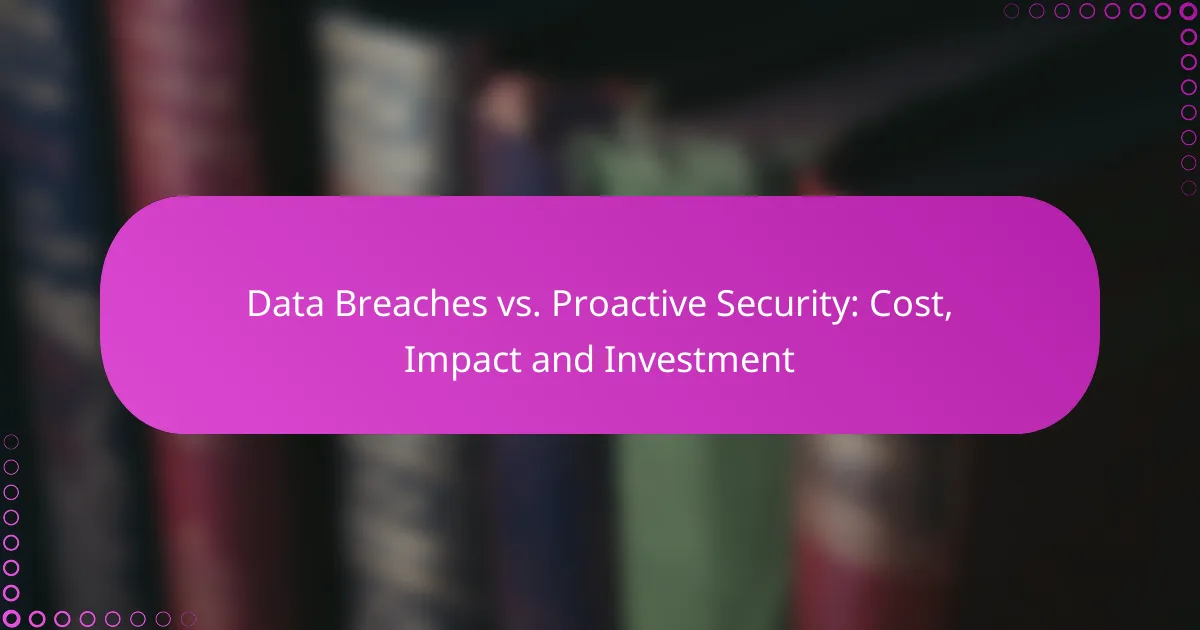In today’s digital landscape, the financial and reputational costs of data breaches can be staggering, often amounting to millions for affected organizations. Proactive security measures, which focus on identifying vulnerabilities and mitigating threats before they escalate, are essential for safeguarding against these risks. By investing in advanced technologies and fostering employee engagement, businesses can significantly reduce the likelihood of data breaches and their far-reaching consequences.

What are the costs of data breaches in the United States?
The costs of data breaches in the United States can be substantial, often reaching into the millions of dollars. These expenses encompass immediate financial losses, long-term reputational harm, and potential legal repercussions.
Average financial impact
The average financial impact of a data breach in the U.S. typically ranges from several million to over ten million dollars, depending on the size and nature of the organization. Factors influencing costs include the number of records compromised, the industry involved, and the effectiveness of the response strategy.
For example, healthcare organizations tend to face higher costs due to the sensitive nature of the data and the regulatory environment. Businesses should prepare for both direct costs, such as forensic investigations and notification expenses, and indirect costs, like lost revenue from customer attrition.
Long-term reputational damage
Long-term reputational damage from a data breach can significantly affect customer trust and brand loyalty. Companies may experience a decline in customer retention rates, leading to reduced revenue over time.
Rebuilding a tarnished reputation can take years and often requires substantial investment in marketing and public relations efforts. Organizations should proactively communicate their commitment to security and transparency to mitigate reputational risks.
Legal and regulatory fines
Legal and regulatory fines can add to the financial burden of a data breach, with penalties varying based on the severity of the incident and applicable laws. Organizations may face fines from state and federal regulators, especially if they fail to comply with regulations like the Health Insurance Portability and Accountability Act (HIPAA) or the General Data Protection Regulation (GDPR).
In some cases, companies may also be subject to lawsuits from affected customers or partners, further increasing their financial liabilities. It is essential for organizations to stay informed about relevant regulations and implement robust compliance measures to minimize this risk.

How does proactive security reduce risks?
Proactive security reduces risks by implementing measures that prevent data breaches before they occur. This approach focuses on identifying vulnerabilities and mitigating threats through advanced technologies and employee engagement.
Implementation of advanced threat detection
Advanced threat detection systems utilize machine learning and artificial intelligence to identify unusual patterns and potential threats in real-time. By continuously monitoring network traffic and user behavior, organizations can detect anomalies that may indicate a breach.
Investing in such systems can significantly decrease the likelihood of successful attacks. For example, organizations that deploy these technologies often report a reduction in incident response times to just a few minutes, compared to hours or days without them.
Employee training and awareness programs
Employee training is crucial in proactive security, as human error is a common factor in data breaches. Regular training sessions help staff recognize phishing attempts and understand security protocols, reducing the risk of accidental breaches.
Organizations should consider implementing ongoing awareness programs that include simulations and updates on the latest threats. This can lead to a more security-conscious culture, where employees actively participate in safeguarding sensitive information.
Regular security audits and assessments
Conducting regular security audits and assessments allows organizations to identify and address vulnerabilities before they can be exploited. These evaluations should include penetration testing and vulnerability scanning to ensure comprehensive coverage.
Establishing a routine for audits—such as quarterly or biannual reviews—can help maintain a robust security posture. Organizations should also stay informed about compliance requirements relevant to their industry, such as GDPR or HIPAA, to ensure they meet necessary standards.

What is the impact of data breaches on businesses?
Data breaches can have severe consequences for businesses, affecting their financial stability, reputation, and operational efficiency. The impact often extends beyond immediate losses, leading to long-term challenges that can hinder growth and customer relationships.
Loss of customer trust
When a data breach occurs, customer trust is often the first casualty. Clients may feel their personal information is no longer safe, leading to a decline in loyalty and potential loss of future business. Rebuilding this trust can take years and requires significant effort in transparency and communication.
To mitigate trust issues, businesses should proactively inform customers about breaches, outline steps taken to rectify the situation, and enhance security measures. Offering identity theft protection services can also help reassure customers.
Operational disruptions
Data breaches can cause significant operational disruptions, as businesses may need to halt services to address vulnerabilities and investigate the breach. This downtime can lead to lost revenue and decreased productivity, affecting both employees and customers.
To minimize disruptions, companies should have an incident response plan in place. Regular training and simulations can prepare teams to act quickly and efficiently, reducing the overall impact on operations.
Increased insurance premiums
Following a data breach, businesses often face increased insurance premiums as insurers reassess risk levels. This can lead to higher operational costs, which may strain budgets, especially for small to medium-sized enterprises.
To manage insurance costs, companies should invest in robust cybersecurity measures and maintain a strong security posture. Demonstrating proactive security investments can help negotiate better terms with insurers and potentially lower premiums over time.

How to choose between data breach response and proactive security?
Choosing between data breach response and proactive security involves evaluating the potential costs and impacts of each approach. Proactive security aims to prevent breaches before they occur, while breach response focuses on managing incidents after they happen.
Cost-benefit analysis
Conducting a cost-benefit analysis is essential in deciding between data breach response and proactive security. Consider the potential financial impact of a data breach, which can range from thousands to millions of dollars, depending on the severity and scale of the incident.
On the other hand, investing in proactive security measures may involve upfront costs but can significantly reduce the risk of breaches and associated losses. Weighing these costs against potential savings from avoiding breaches can guide your decision.
Assessment of company size and industry
The size of your company and the industry you operate in play crucial roles in determining the appropriate security strategy. Larger organizations often face more complex threats and may require robust proactive measures, while smaller businesses might focus on efficient breach response strategies.
Industry regulations also influence this choice. For example, healthcare and finance sectors have stringent compliance requirements, making proactive security investments more critical to avoid hefty fines and reputational damage.
Evaluation of existing security measures
Assessing your current security measures is vital in deciding whether to enhance proactive security or improve breach response capabilities. Identify any gaps in your existing systems that could leave your organization vulnerable to attacks.
Consider conducting regular security audits and penetration testing to evaluate the effectiveness of your current measures. This evaluation can help prioritize investments in either proactive security enhancements or incident response improvements based on identified weaknesses.

What are the investment trends in cybersecurity?
Investment trends in cybersecurity show a significant increase as organizations recognize the importance of protecting their data. Companies are allocating more resources to enhance their security measures, driven by the rising frequency and sophistication of cyber threats.
Growth in cybersecurity spending
Cybersecurity spending has been growing rapidly, with many organizations increasing their budgets by double-digit percentages annually. This trend reflects the urgent need to defend against data breaches, which can cost businesses millions in recovery and reputational damage.
According to industry reports, global spending on cybersecurity is expected to reach hundreds of billions of USD in the coming years. Companies are focusing on both preventive measures and incident response capabilities to mitigate risks effectively.
Emerging technologies in security
Emerging technologies are reshaping the cybersecurity landscape, with innovations such as artificial intelligence (AI), machine learning, and blockchain gaining traction. These technologies help organizations detect threats more efficiently and automate responses, reducing the time to mitigate risks.
For instance, AI-driven security solutions can analyze vast amounts of data to identify unusual patterns, enabling proactive threat detection. Investing in these technologies can enhance an organization’s overall security posture and provide a competitive edge.
Investment in employee training
Employee training is a critical component of cybersecurity investment, as human error remains a leading cause of data breaches. Organizations are increasingly recognizing the need to educate their staff on security best practices and potential threats.
Regular training sessions, phishing simulations, and awareness programs can significantly reduce the likelihood of successful attacks. Allocating a portion of the cybersecurity budget to employee training ensures that all team members are equipped to recognize and respond to security threats effectively.

What are the future trends in proactive security?
Future trends in proactive security focus on advanced technologies and frameworks that enhance defense mechanisms against potential threats. Organizations are increasingly adopting innovative strategies to prevent data breaches and mitigate risks before they escalate.
AI and machine learning applications
AI and machine learning are transforming proactive security by enabling systems to analyze vast amounts of data for unusual patterns and potential threats. These technologies can identify anomalies in real-time, allowing for quicker responses to security incidents.
For instance, machine learning algorithms can continuously learn from new data, improving their accuracy over time. Organizations can implement AI-driven tools to automate threat detection and response, reducing the reliance on manual monitoring.
Zero trust security models
Zero trust security models operate on the principle of “never trust, always verify,” requiring strict identity verification for every user and device attempting to access resources. This approach minimizes the risk of unauthorized access and data breaches by assuming that threats could originate from both outside and inside the network.
Implementing a zero trust model involves segmenting networks, enforcing least privilege access, and continuously monitoring user behavior. Organizations should consider adopting multi-factor authentication and robust access controls to strengthen their zero trust strategies.










